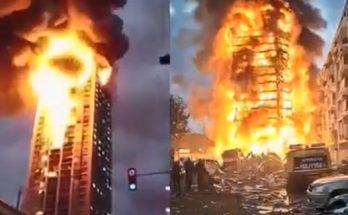A Fragile Peace: Inside the Trump-Brokered Cease-Fire Between Israel and Iran and the Uncertain Future of the Middle East
A fragile stillness has once again descended uneasily across the Middle East — but beneath that veneer of calm, tension simmers dangerously close to boiling over. The cease-fire between Israel and Iran, brokered by former President Donald Trump, was meant to halt nearly two weeks of deadly clashes. Instead, within hours of its declaration, missile exchanges and counterclaims have pushed the region back toward the brink of full conflict.
For twelve consecutive days, the skies over the region were streaked with rockets and anti-missile fire. Cities were scarred, communities disrupted, and countless families forced from their homes. The destruction was tangible, and the psychological toll heavy.
Then, early on a Tuesday morning, Trump stepped forward with a dramatic announcement: a truce. He billed it as a “breakthrough for peace in our time.” The statement caught global attention — bold in tone, dramatic in delivery, and deeply uncertain in its implications.
On paper, the agreement was straightforward: both sides would immediately halt military operations and engage in mediated, indirect talks through international intermediaries. But in a region as volatile as the Middle East, simple theory rarely survives contact with reality. Within mere hours of the truce announcement, signs began to surface that the peace was already fraying.
Israeli defense officials claimed the calm shattered soon after sunrise, alleging that Iran launched multiple missiles toward southern Israel. Air-raid sirens screamed across cities and towns, sending civilians scrambling to shelters. The Israeli Defense Forces confirmed at least four missile strikes — one hitting a residential building in Beersheba, causing multiple casualties, including the deaths of four civilians.
Israel responded swiftly, describing its counterattack as “targeted defensive measures” aimed at “active missile platforms” located in western Iran. Meanwhile, Iranian state media fiercely denied any missile launches, accusing Israel of concocting the story as a pretext for renewed aggression. With these starkly divergent narratives, independent observers were left struggling to determine exactly what occurred — let alone who struck first.
Even before the missile reports surfaced, many analysts doubted the cease-fire’s durability. In the preceding 12 days of fighting, both nations had proclaimed victory — a political signal that neither was ready to yield ground. Israel claimed it had fulfilled its objectives “in alignment with President Trump’s peace framework,” while Iran framed the truce as proof that its deterrence force compelled Israel to come to the negotiating table.
In other words, both felt victorious — making a genuine, stable compromise inherently unstable.
In the first hours following the cease-fire, Israel remained cautious, withholding public commentary and waiting to see whether quiet would hold. By mid-morning, formal acknowledgments of the truce emerged from both nations. But barely two hours later, air-raid sirens sounded again across northern Israel, indicating fresh missile launches.
Israel’s Prime Minister Naftali Cohen addressed the nation: “Any violation of this agreement will be met with decisive action.” His defense minister echoed the strain: “Israel will not tolerate attacks, even disguised as peace.” Iranian leaders, in turn, accused Israel of orchestrating false-flag operations to undermine the truce. “These accusations are baseless,” an Iranian military spokesperson insisted. “Iran has fully respected the cease-fire agreement. Any aggression on our sovereign territory invites a proportionate response.”
Thus began a war of narratives — two nations waging conflict not just with weapons, but with competing versions of truth.
The Civilian Toll
To ordinary people, the political posturing scarcely matters. The cease-fire was supposed to offer a brief respite — a moment to breathe after days of terror. Instead, fear remains pervasive.
Schools stayed shuttered. Families slept in bomb shelters. Hospitals remained overflowing with wounded from earlier attacks. In a region where the sounds of sirens and distant explosions had become habitual, silence itself turned into a warning.
“The truce changed nothing,” said Lior Ben-David, a teacher in Ashkelon. “We still jump at every noise. We dare not send our children to school. Peace? This isn’t peace — it’s a symptom of exhaustion between nightmares.”
The humanitarian crisis is not confined to Israel. In Iran, citizens grapple with the social and economic pressures wrought by prolonged sanctions and ongoing military tension. Across adjacent nations — Lebanon, Jordan, and Iraq — governments watch anxiously, fearful that escalation could spill across borders.
Global markets reacted instantly. Oil prices surged within hours of the reported missile launches — a stark reminder of how vulnerable the world economy remains to instability in the region.
Trump’s Role and the Shadow of His Legacy
This cease-fire marks yet another, and perhaps most controversial, chapter in Donald Trump’s post-presidential engagement in global diplomacy. Despite no longer holding formal office, he presented himself as unique among mediators — the only figure who could bridge the Israeli-Iranian divide, leveraging relationships and deals formed during his presidency.
His unveiling was theatrical: flanked by cameras, he declared, “History will remember this day as the moment peace came back to the Middle East.”
Yet as missiles began to fly again within hours, many critics accused him of grandstanding. “You can’t strong-arm peace,” commented a European diplomat. “A cease-fire built on no trust is like patching a cracked dam with tape — sooner or later, it bursts.”
Still, Trump’s supporters countered that any reduction in violence, however fleeting, is a better alternative to open war. “It’s a step,” said a former White House aide. “A shaky one, certainly. But still a step away from full-scale conflict.”
The Global Chorus: Calls for Restraint
International institutions and regional actors wasted no time issuing urgent appeals. The United Nations, the European Union, and the Arab League all called for calm. UN Secretary-General António Guterres cautioned that “the risk of escalation remains dangerously high,” urging both parties to honor the cease-fire and return to diplomacy.
Russia and China — both with vested interests in Iran — expressed serious concern and urged restraint, cautioning against further U.S. interference. Meanwhile, the U.S. State Department under the Biden administration has tread carefully: neither embracing Trump’s involvement nor openly denouncing it.
“The key priority is stability,” one senior U.S. official said. “We support any initiative that diminishes violence. But lasting peace cannot be built on photo-ops and declarations alone.”
A Region Strained to the Breaking Point
Twelve days of warfare may pale beside some historical conflicts — but in so short a span, the destruction was significant. Satellite surveys revealed entire Israeli neighborhoods leveled, while Iranian military complexes suffered heavy damage.
Casualty numbers remain contested. Israel reported dozens of dead and hundreds wounded. Iran has offered no official toll. Either way, the psychological wounds are deep: fatigue, dread, and pervasive uncertainty.
Even if the cease-fire holds, deeper issues remain unresolved — territorial disputes, proxy conflict, religious and ideological fault lines. “This is not peace,” warns regional analyst Dr. Laila Husseini. “It’s the calm at the eye of a brewing storm.”
The Precarious Quiet
As night closed in on Tuesday, missile sirens finally fell silent — but few dared to embrace the stillness. In Tel Aviv, families ventured outdoors for the first time in days, uneasy but longing for normalcy. In Tehran, citizens hovered over radios and news feeds, awaiting confirmation that hostilities had truly ceased.
For the moment, both sides appear to be holding their fire — perhaps to regroup, perhaps to deceive. But the lesson is clear to diplomats and civilians alike: this calm is tenuous at best.
The Trump-mediated cease-fire may have paused the missiles, but it did not extinguish the smoldering embers. The Middle East remains a powder keg — one spark away from eruption.
As the world watches with bated breath, a single truth looms: in a land shaped by history, revenge, and survival, peace is not declared in press statements. It is painstakingly built — day by day, through fragile silences after the storm.



